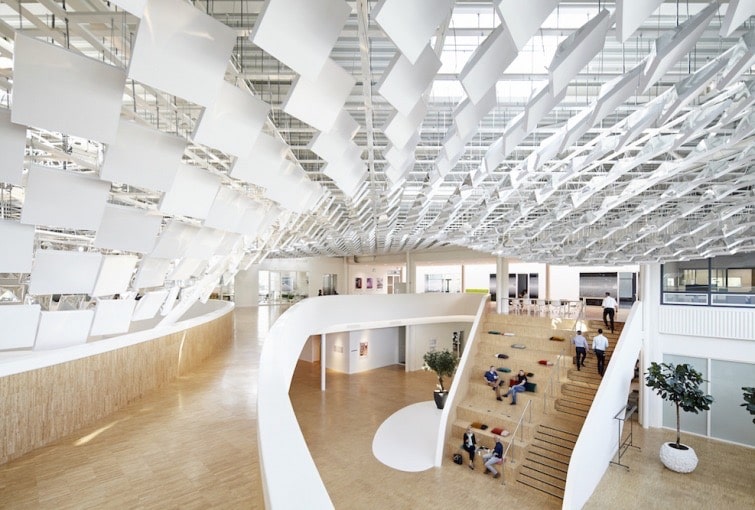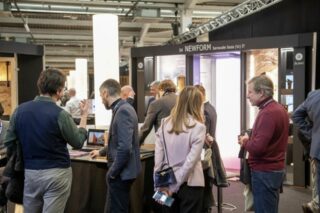There’s a lighting revolution going on at the moment—and its forever-changing built environments as we know them. Thanks to a few recent major scientific breakthroughs, we now know that a life spent mostly indoors has a profound impact on our health. And not in a good way. In response, and pushed by organizations such as the Human Centric Lighting Society, innovation in lighting technology is increasingly turning away from a lights-on, lights-off approach and turning towards people and their personal needs. During the trade fair Light + Building, from March 18 to 23 in Frankfurt am Main, a major topic for many of the nearly 3,000 exhibitors was Human Centric Lighting (HCL)—or lighting that influences our internal biological clock.
Increased attention on HCL is directly correlated to science. In 2001, the discovery of a new receptor in the retina proved ground-breaking. The findings pointed to a light-sensitive cluster of cells that regulate biological processes in the body when light reaches them. In 2017, the Nobel Prize for Medicine was awarded jointly to three US researchers “for their discoveries of molecular mechanisms controlling the circadian rhythm,” according to the Nobel Prize committee. Revealed through investigations into the period gene of the fruit fly, this award drove home what was already suspected—that behavior, hormone levels, sleep, body temperature, blood pressure and metabolism are all influenced by light.
In the industrial lighting world, this means the role of lighting in a built-up environment is unexpectedly powerful. It can keep you awake like a strong cup of coffee or knock you out like an Ambien. Then there are all the varying emotions and energy levels in-between.
Data-Driven Research Paving the Way
“Thirty-three percent of the working population have sleep problems, as well as problems with moods, concentration and behavior,” says Bianca van der Zande, a scientist specializing in HCL for Philips Lighting.
A global leader in the HCL field, Philips Lighting is driving its lighting solutions with data-driven research. Drawing from experts in various fields—ranging from psychologists, biologists and lighting application specialists to data analysts and business developers—the company has teams around the globe going to work every day to focus on the HCL topic.

An interactive light tree designed by LAVA architects at the Philips headquarters in Eindhoven, the Netherlands. Photo courtesy of Philips.
“In 2001, lighting was still more or less at the start of LED-ification, when we were moving from traditional lighting solutions to LED,” says van der Zande.
“Today, with LED well-integrated and all the new control systems, it is much easier to create solutions in an energy- and cost-sensitive way.
Read our opinion piece by architect Marina Kodakoff, whose research office RSK Architecture focuses on architecture and neuroscience, in which the use of LEDs is questioned.
To conduct its research, Philips Lighting adapts to each market segment—HCL application in an office is going to be different than it would be in a residential or hospitality setting. “Sleep is a difficult theme to sell in the office space,” van der Zande notes wryly.
How results are measured also depends on application. In schools, learning productivity is a likely indicator, while in hospitals different areas might have particular importance.
“Especially in the US, patient satisfaction there is directly linked to the financial benefit of hospitals,” van der Zande reveals.

At the Czech Republic headquarters of energy company Innogy, a Philips LED lighting system supports the circadian rhythms of staff, including stimulating their energy levels at set times in the day. Photo courtesy of Philips Lighting.
Similarly, another HCL leader, lighting manufacturer Siemens, is closely cooperating with leading research institutes to continuously integrate the latest HCL findings into its concepts and solutions.
“More and more research is giving us evidence about the impact of light on human physiology,” explains lighting designer Andreas Hartwig of the Siemens Building Technologies Division. “Siemens has always integrated lighting controls into its total room automation and control solutions, so today we are ready with so-called Human Centric Lighting solutions.”
Taking a Holistic Approach
Hartwig points out that a holistic approach is crucial. The ideal HCL application doesn’t just depend on lighting systems—“the control of daylight via blinds is also significant,” he stresses. “From a technical perspective, we are driving the holistic approach to not only focus on one subsection but to integrate as many different systems as possible to interlock them.” Case in point, with the Siemens Desigo Total Room Automation system, it is possible to control color temperature and intensity over the day.

An interactive light tree designed by LAVA architects at the Philips headquarters in Eindhoven, the Netherlands. Photo courtesy of Philips.
Philips Lighting has a similar system showcased in the atrium of its corporate headquarters in Eindhoven, the Netherlands. There, an interactive light tree designed by architecture firm LAVA is programmed to roll through a non-repetitive light show for the entire calendar year. With 1,500 “leaves” of Philips Soundlight Comfort lights, the tree responds to seasons, time of day and the architectural layout of the atrium space—just like sunlight.
![[Light+Building] Insiders Weigh in on Human Centric Lighting](/wp-content/uploads/sites/7/LAVA-architects-philips-headquarters-1.jpg)










